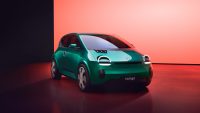New car registrations fell by around a quarter in October, new data shows.
Figures from the Society of Motor Manufacturers and Traders (SMMT) shows 106,265 units were registered during the month, down by 24.6 per cent on October 2020, making it the worst performing October since 1991.
The SMMT has again revised its full-year forecast downwards due to the ongoing semiconductor shortage and tax rises – it’s now down by 8.8 per cent to 1.66m units.
It means 2021 would finish 1.9 per cent or some 30,000 units up on 2020, but some 650,000 units down on 2019’s pre-pandemic 2.3m performance.
Uptake for pure-electrics equalled their September market share of 15.2 per cent with 16,155 units, while plug-in hybrid vehicles (PHEVs) grew to 7.9 per cent or 8,382 units.
It means cars with plugs now account for 16.6 per cent of all new car registrations in 2021.
Add in a further 9.1 per cent from hybrid electric vehicles, it means that 25.7 per cent, or more than a quarter of the new car market, has been electrified year-to-date.
All car segments fell, except the ‘Mini’ category.
The Volkswagen Polo was October’s best-selling car, while for the second month running, the Ford Fiesta didn’t appear in the top 10.
The Vauxhall Corsa remains the year-to-date best-seller, followed by the Volkswagen Golf and Polo. The Fiesta has slipped to fifth place, just a few units ahead of its Puma sister car.
The SMMT did issue some positivity, however, saying that it expects 1.96m new car registrations next year, driven primarily by demand for plug-in vehicles, which are expected to outsell diesels and mild-hybrid diesels.
SMMT chief Mike Hawes said: ‘The current performance reflects the challenging supply constraints, with the industry battling against semiconductor shortages and increasingly strong economic headwinds as inflation rises, taxes increase and consumer confidence has weakened.
‘Electrified vehicles, however, continue to buck the trend, with almost one in six new cars registered this year capable of zero-emission motoring, growth that is fundamental to the UK’s ability to hit its net zero targets.
‘With next year looking brighter, and even more new models expected, the continuation of this transition will depend on the preservation of incentives that overcome the affordability barrier, and the ability of the public and private sectors to increase public on street charging to allay EV driver concerns.’
What the industry says
Still a huge price disparity
Demand for new electric vehicles continues to grow with almost 25 per cent of new car considerers viewing an electric vehicle on Auto Trader in October, up from just 7.7 per cent in October 2020. However, the extent to which interest can be converted into purchase remains a concern given the huge price disparity. The average new EV is 38 per cent more expensive than its petrol equivalent.
The fuel crisis has been the most significant catalyst for increasing consumer interest in EVs. We always say that cost and convenience are the key drivers of car purchasing. EVs are at a disadvantage on both fronts, but the empty petrol pumps and massive queues have certainly challenged that.
Ian Plummer, commercial director, Auto Trader
EVs aren’t insulated from wider energy crisis
October is traditionally a quieter month after September’s plate change. But a gloomy picture is compounded by fewer cars rolling off production lines due to supply chain challenges, and the beginnings of shakier consumer confidence with the looming threat of interest rate rises. Such factors are contributing to a booming second-hand market at the cost of new car sales.
The impact that record high fuel prices will have on pushing motorists towards electric vehicle (EV) options shouldn’t be understated. Yet EVs aren’t insulated from the wider energy crisis. A tough winter for energy companies will make plug-in drivers think carefully about their tariffs to avoid unexpectedly high bills.
Richard Peberdy, UK head of automotive, KPMG
EVs are one to watch
This run of poor figures is creating an overhang in the market, so dealers will hope they can meet some of the consumer demand that had been left unsatisfied over the weeks and months ahead. Unfortunately this demand still outstrips available supply, so forecourts across the country will be having to prioritise the delivery of their current order book as well as meeting the challenge of future purchases.
Cop26 has sustainability at the front of everyone’s minds at the moment, and prospective car buyers are clearly no exception. New registrations of ‘battery electric vehicles’ continue to perform well, and whilst comparative volumes may be small the percentage increases we are seeing are significant. This area will certainly be one to watch as we go into the new year.
Karen Johnson, head of retail & wholesale at Barclays Corporate Banking
Thousands forced into used market
October’s double whammy of fuel shortages and rapidly rising fuel prices certainly gave EVs the best possible advert, encouraging many buyers who had already been considering a switch to an EV to bring forward their decision. The buzz around EVs created by this week’s Cop26 Summit in Glasgow may nudge even more drivers to go electric in coming months.
But with demand outstripping the supply of many new models, thousands of motorists are choosing to focus on the second-hand market instead, where availability is significantly better.
James Fairclough, CEO, AA Cars
Buyers willing to wait
In October, the government announced its Net Zero strategy, which included £620m further investment into the infrastructure required for electric vehicles against a backdrop of the fuel shortages, a move which will help buyers make the switch in the long run, and which has driven another short-term surge in interest in EVs.
However, in the short term the industry is still struggling with the ongoing microchip shortage, with some manufacturers quoting waiting times beyond 12 months for some models.
While this has pushed buyers to the used market, our independent research of in-market buyers since April has found new car buyers are also extending their waiting times – with the share of new car buyers willing to wait more than 16 weeks for their vehicle to arrive rising from 19 per cent in April to 34 per cent by the end of October.
Jim Holder, editorial director, What Car?


































